Kalimantan Selatan
South Kalimantan
South Kailimantan
Wadja Sampai Kaputing - Sekuat baja sampai akhir - Strong as steel until the end
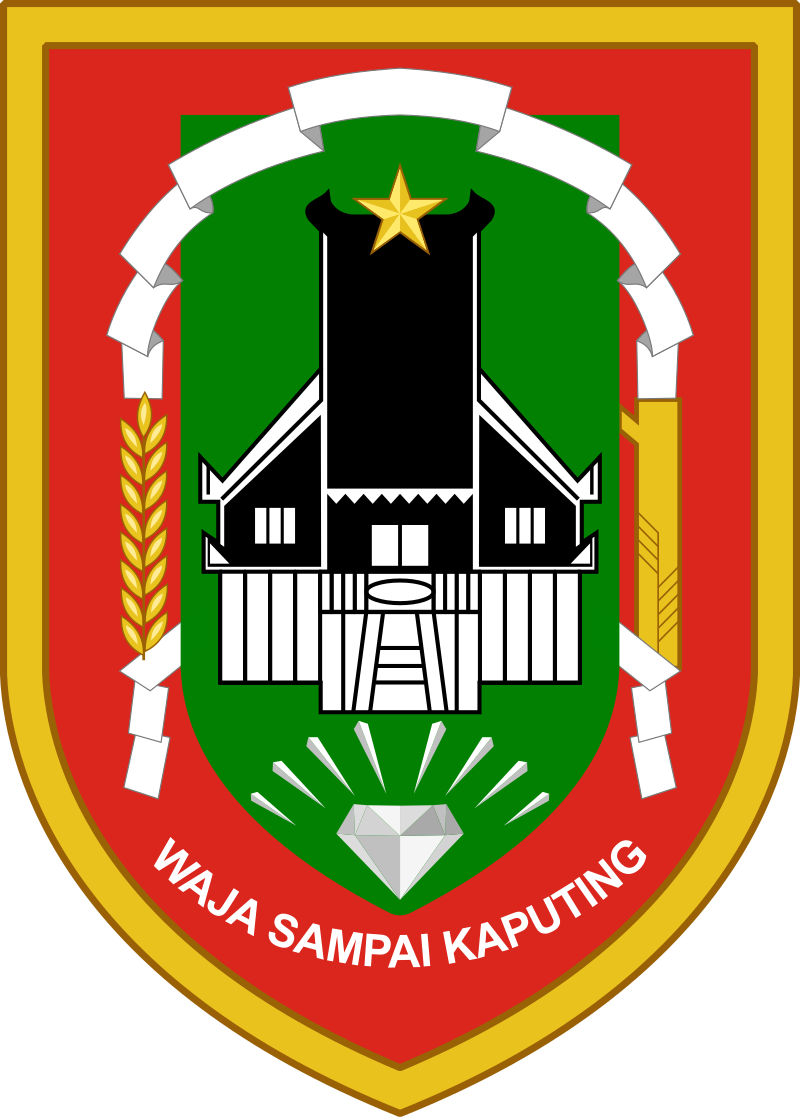 South Kalimantan (Indonesian: Kalimantan Selatan) is a province of Indonesia. It is the smallest province in Kalimantan, the Indonesian territory of Borneo. The provincial capital was Banjarmasin until 15 February 2022 when it was legally moved to Banjarbaru. The population of South Kalimantan was recorded at just over 3.625 million people at the 2010 Census, and at 4.07 million at the 2020 Census. The official estimate as at mid 2021 was 4,112,576. One of the five Indonesian provinces in Kalimantan, it is bordered by the Makassar Strait in the east, Central Kalimantan in the west and north, the Java Sea in the south, and East Kalimantan in the north.
South Kalimantan (Indonesian: Kalimantan Selatan) is a province of Indonesia. It is the smallest province in Kalimantan, the Indonesian territory of Borneo. The provincial capital was Banjarmasin until 15 February 2022 when it was legally moved to Banjarbaru. The population of South Kalimantan was recorded at just over 3.625 million people at the 2010 Census, and at 4.07 million at the 2020 Census. The official estimate as at mid 2021 was 4,112,576. One of the five Indonesian provinces in Kalimantan, it is bordered by the Makassar Strait in the east, Central Kalimantan in the west and north, the Java Sea in the south, and East Kalimantan in the north.
The province also includes the island of Laut, located off the eastern coast of Kalimantan. The province is divided into 11 regencies and 2 cities. South Kalimantan is the traditional homeland of the Banjar people, although some parts of East Kalimantan and Central Kalimantan are also included in this criteria. Nevertheless, South Kalimantan, especially the former capital city Banjarmasin has always been the cultural capital of Banjarese culture. Many Banjarese have migrated to other parts of Indonesia, as well as neighbouring countries such as Singapore and Malaysia. In addition, other ethnic groups also inhabit the province, such as several groups of the Dayaks, who mostly live in the interior part of the province, as well as the Javanese, who mostly migrated from Java due to the Transmigration program which dated from the Dutch colonial era.
Banjar rose in the first decades of the 17th century as a producer and trader of pepper. Soon, virtually all of the southwest, southeast, and eastern areas of Kalimantan island were paying tribute to the sultanate. Sultan Agung of Mataram (1613–1646), who ruled north Java coastal ports such as Jepara, Gresik, Tuban, Madura and Surabaya, planned to colonise the Banjar-dominated areas of Kalimantan in 1622, but the plan was cancelled due to inadequate resources. Europeans began arriving in the region in the 16th century. The Dutch initially built a trade post in the region, but was expelled by the British during the Napoleonic Wars. After the war ended, the British returned the region to the Dutch.
A new round of history in South Kalimantan began with the rise of the people against the Dutch. Prince Antasari led the resistance against the Dutch, whom eventually abolished the sultanate, while Sultan Muhammad Seman, who became its leader, died in battle. Afterwards South Kalimantan was fully controlled by the Dutch. Japanese forces took control of the region in 1942, resulting in the three years of brutal occupation before surrendering in 1945. The Dutch briefly returned to assume control, but this resulted in a nationwide resistance. In 1949, the Dutch left and control of the region was handed to the new Indonesian Government.
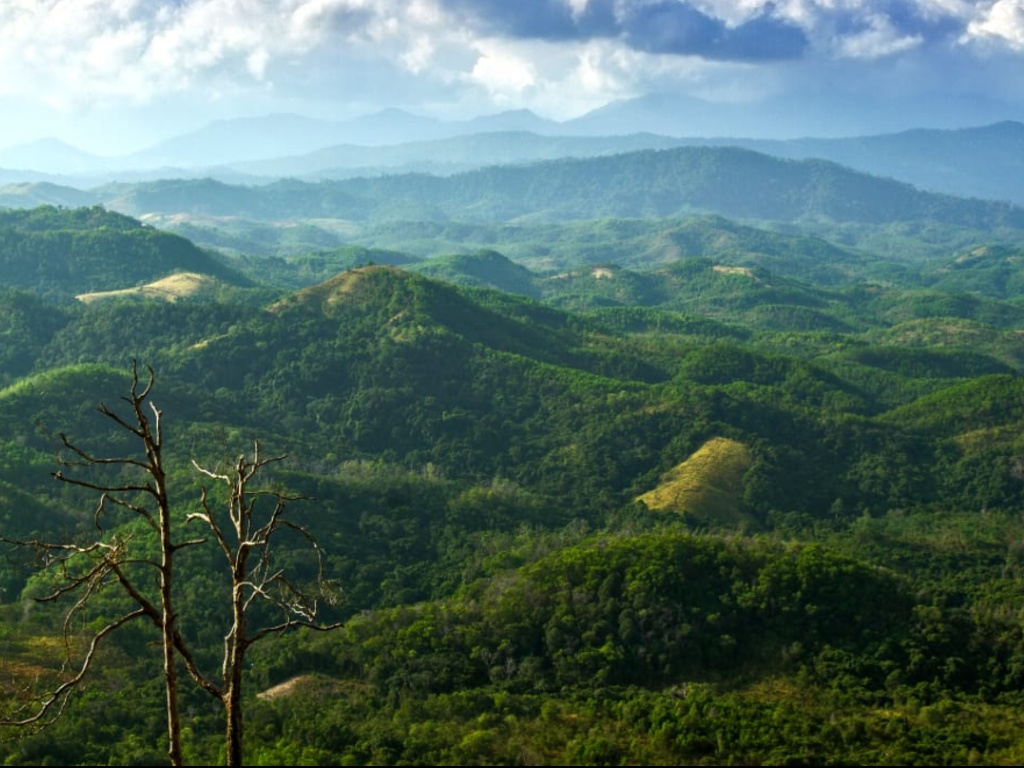 Etymology
Etymology
South Kalimantan is known as the Land of Lambung Mangkurat (Indonesian: Bumi Lambung Mangkurat). Lambung Mangkurat, which is the Banjarese pronunciation for Lambu (Lembu) Mangkurat, was the second king of the Kingdom of Dipa (the forerunner of the Banjar Sultanate). Lambung Mangkurat replaces his father Ampu Jatmaka or Mpu / Empu Jatmika ang Maharaja in Candi, a wealthy immigrant merchant from the land of Keling, Kediri who was the founder of the kingdom of Dipa around the beginning of the 14th century or around 1380 or 1387.
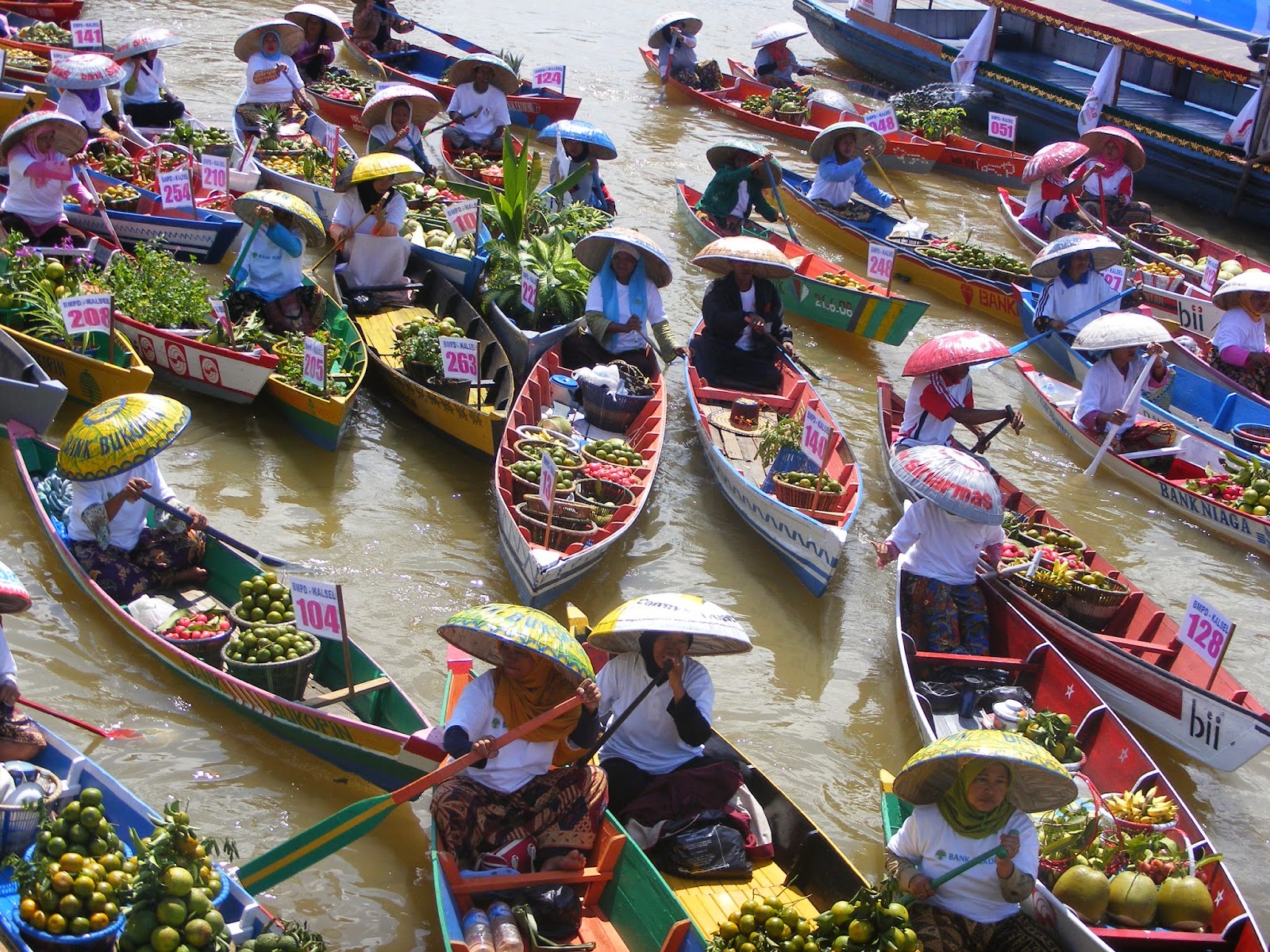 History
History
On September 17, 1945, Japan surrendered to the Australian Army who entered Banjarmasin. On July 1, 1946, the Australian handed control back to the Dutch colonial government. Governor-General Hubertus van Mook draw up a plan for a federal government through the Malino Conference (July 16–22, 1946) and the Denpasar Conference (December 7–24, 1946) which decided the formation of four states namely Java, Sumatra, Borneo (Netherlands Borneo) and the Great East (State of East Indonesia), but the formation of the Borneo state was blocked opposed by the people of Banjarmasin, led by several figure such as Hasan Basry.
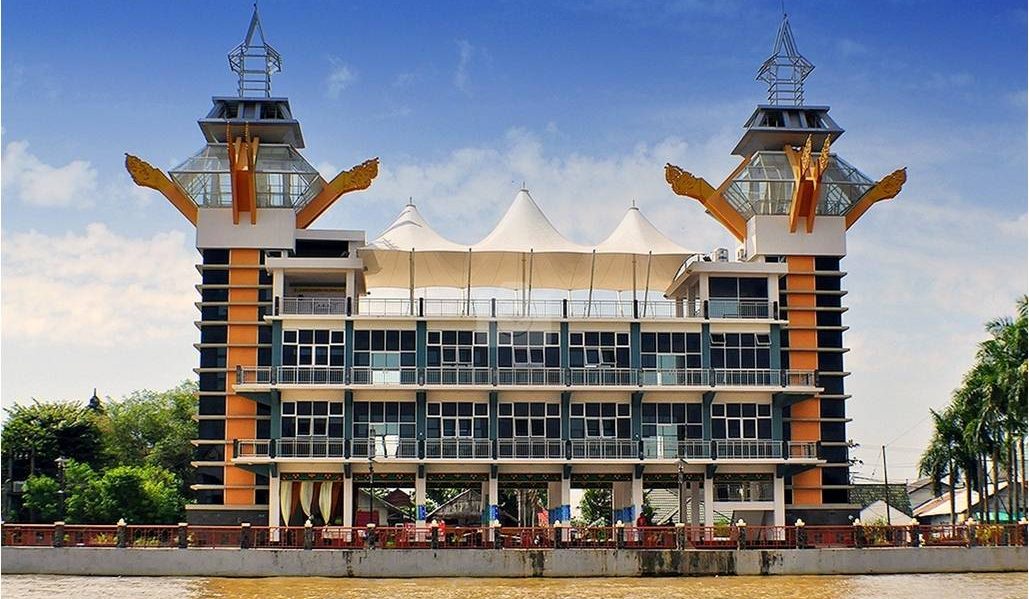 The Dutch remained in South Kalimantan until 1949, when the Dutch–Indonesian Round Table Conference resulted in the Dutch recognizing Indonesia’s sovereignty. The Dutch then withdraw from the region, ending the three-century long Dutch presence in the region.
The Dutch remained in South Kalimantan until 1949, when the Dutch–Indonesian Round Table Conference resulted in the Dutch recognizing Indonesia’s sovereignty. The Dutch then withdraw from the region, ending the three-century long Dutch presence in the region.
The region was initially incorporated into the Indonesian province of Kalimantan, but in 1956 the province was dissolved and separated into two province, West Kalimantan and South Kalimantan. In 1957 South Kalimantan was divided to provide the Dayak population with greater autonomy from the Muslim population in the province. The change was approved by the Indonesian Government on May 23, 1957, under Presidential Law No. 10 Year 1957, which declared Central Kalimantan the seventeenth province of Indonesia.
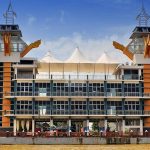
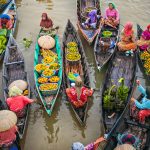

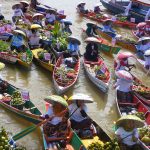
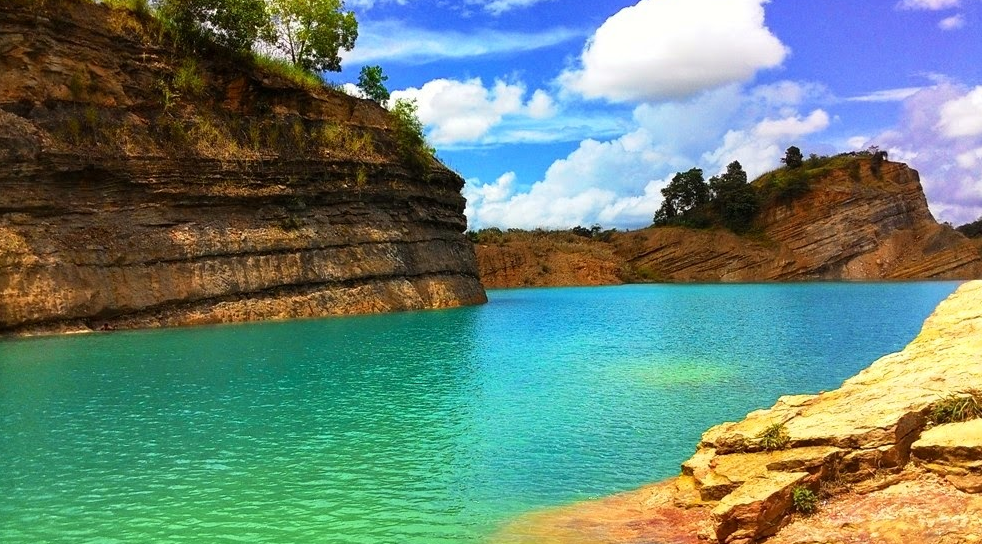 Geography
Geography
Geography South Kalimantan is a province located on the island of Borneo, located between longitude 21 21 49 “LS, 114 19” 33 “BT – 116 33 ’28 BT, and 21′ 49” LS 110 “14” LS on the map. South Kalimantan has a total area of 38,744.23 km2 and is divided into eleven regencies (kabupaten) and two independent cities (kota).
These include Kotabaru Regency (which is the largest regency in South Kalimantan with an area of 13,044.50 km2), Banjar Regency (with an area of 5,039.90 km2) and Tabalong Regency (with an area of 3,039.90 km2), while the city of Banjarmasin is the smallest area (with an area of just 72.00 km2).
 Geographically, South Kalimantan is in the southeastern part of the island of Borneo, has a low-lying area in the west and east coast, and a plateau formed by the Meratus Mountains in the middle. South Kalimantan consists of two main geographic features, namely the lowlands and the highlands. Lowland areas are mostly in the form of peatlands to swamps, which are rich in biodiversity sources of freshwater animals.
Geographically, South Kalimantan is in the southeastern part of the island of Borneo, has a low-lying area in the west and east coast, and a plateau formed by the Meratus Mountains in the middle. South Kalimantan consists of two main geographic features, namely the lowlands and the highlands. Lowland areas are mostly in the form of peatlands to swamps, which are rich in biodiversity sources of freshwater animals.
Some highland areas are still natural tropical forests and protected by the government. South Kalimantan has extensive forests namely Permanent Forests (139,315 ha), Production Forests (1,325,024 ha), Protected Forests (139,315 ha), Convention Forests (348,919 ha). Forestry consists of two types, namely wood and non-wood. The area of forest in South Kalimantan is 1,659,003 ha including; protected forests, natural forests, permanent production forests, limited production forests, conversion forests and mangrove forests. Some are tropical forests and protected by the government.
 South Kalimantan is known as “the land of a thousand rivers”, it is due to the large number of rivers in South Kalimantan. From these rivers, one of the well-known rivers is the Barito River, whose name is based on the Barito region (formerly Onder Afdeeling Barito) which is upstream including Central Kalimantan, but is often used to name all of the watershed to its mouth at the Java Sea in South Kalimantan is called Muara Banjar/Kuala Banjar.
South Kalimantan is known as “the land of a thousand rivers”, it is due to the large number of rivers in South Kalimantan. From these rivers, one of the well-known rivers is the Barito River, whose name is based on the Barito region (formerly Onder Afdeeling Barito) which is upstream including Central Kalimantan, but is often used to name all of the watershed to its mouth at the Java Sea in South Kalimantan is called Muara Banjar/Kuala Banjar.
Barito River is commonly used for buying and selling floating markets. In addition, there is also the Martapura River, a tributary of the Barito, which is located in the city of Banjarmasin and in the upper part is the city of Martapura, the capital of Banjar Regency.
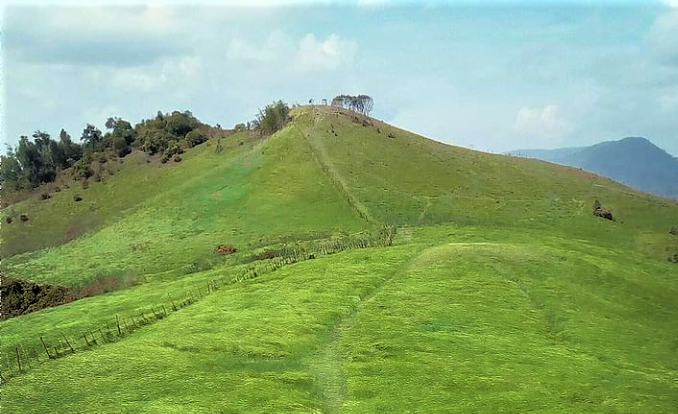 Climate
Climate
This region has a tropical savanna climate, similar to most other Indonesian provinces. The season in West Sumatra is similar to other regions in Indonesia, only known for two seasons, namely the dry season and the rainy season. From June to September wind flows from Australia and do not contain much water vapor, resulting in a dry season.
Conversely in December to March many wind currents contain water vapor from Asia and the Pacific Oceanduring the rainy season. Such conditions occur every half-year after passing the transition period in between April – May and October – November.
As in most other province of Indonesia, South Kalimantan has a tropical rainforest climate (Köppen climate classification Af) bordering on a tropical monsoon climate and tropical savanna climate (Köppen climate classification Aw) along the savanna grassland plains. The climate is very much dictated by the surrounding sea and the prevailing wind system. It has high average temperature and high average rainfall.
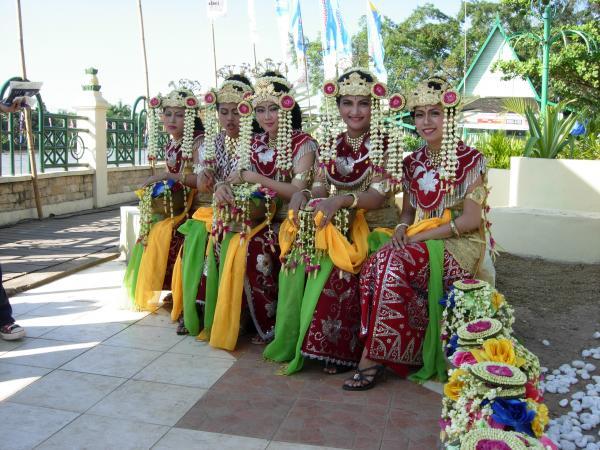 Demographics
Demographics
Ethnicity. The majority of the population of South Kalimantan is the Banjar (74.34%) consisting of three groups, namely Banjar Kuala, Banjar Pahuluan and Banjar Batang Banyu. Based on the 2010 population census the Banjar people numbered 4.1 million. About 3 million Banjar people live in South Kalimantan, another million Banjar people live in other Kalimantan regions and 500,000 other Banjars live outside Kalimantan.
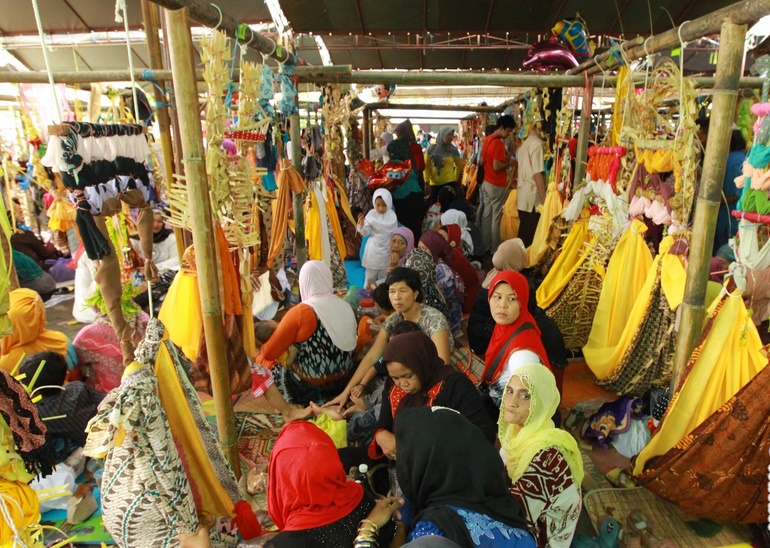 The Banjar people originated from the Banjar area, which is a mix of communities in several rivers, namely Bahan, Barito, Martapura and Tabanio. From this central cultural area, the Banjar tribe has since moved extensively for centrifugal migration or jumping of frogs to various regions in the archipelago to Madagascar.
The Banjar people originated from the Banjar area, which is a mix of communities in several rivers, namely Bahan, Barito, Martapura and Tabanio. From this central cultural area, the Banjar tribe has since moved extensively for centrifugal migration or jumping of frogs to various regions in the archipelago to Madagascar.
The second largest ethnic group is the Javanese (14.51%) who occupy the transmigration area. Other ethnic groups also exist in South Kalimantan. The Tionghoa Parit (Banjarese: Cina Parit) is a sub-group of the Chinese Indonesians. They inhabit the Parit river area in Pelaihari, Tanah Laut Regency, South Kalimantan. Chinese people in Banjarmasin live in the Chinatown area which consists of the Pacinan Laut Village (near the river) and Pacinan Darat Village (from the river).
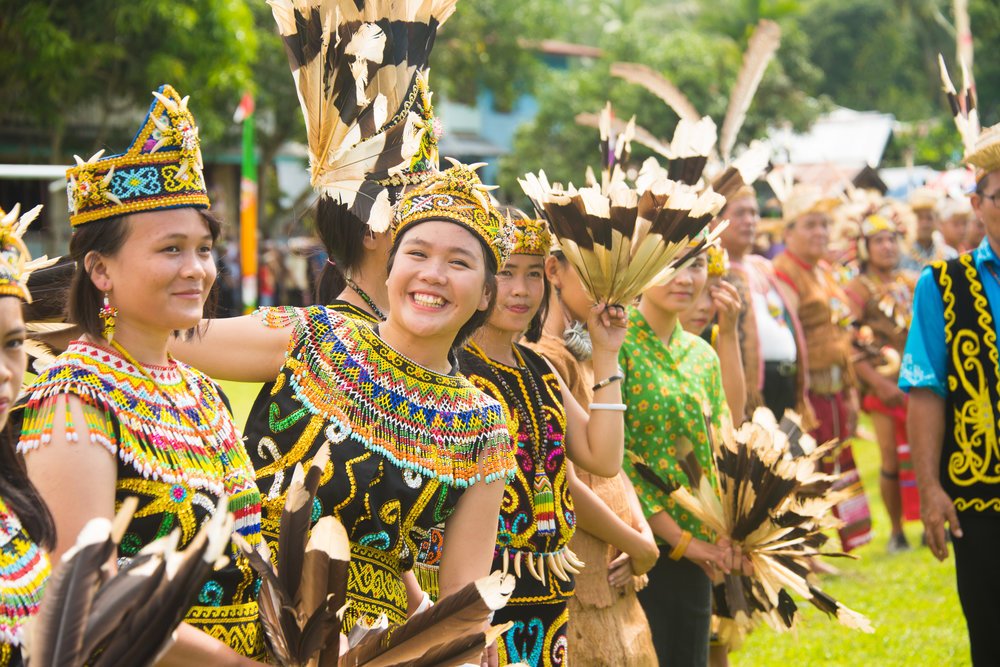 The Dayak are also of the original inhabitants of the province. They occupy the Meratus Mountains region and the Barito River flow to Central Kalimantan.
The Dayak are also of the original inhabitants of the province. They occupy the Meratus Mountains region and the Barito River flow to Central Kalimantan.
The language used in everyday life by Banjarese as a mother tongue and as a lingua franca for the people of South Kalimantan generally is the Banjar language which has two major dialects, namely Banjar Kuala dialects and Banjar Hulu dialect. Dayak tribes who inhabit the southern region of the Meratus mountains spoke the Dayak Meratus language.
 The Dayak Dusmala (Dusun-Maanyan-Lawangan) that use Eastern Barito language inhabit the northern region of the Meratus Mountains uses the Dayak Maanyan Warukin language, Dayak Samihin language, Dayak Dusun Deyah language, Dayak Lawangan language, and Dayak Abal language.
The Dayak Dusmala (Dusun-Maanyan-Lawangan) that use Eastern Barito language inhabit the northern region of the Meratus Mountains uses the Dayak Maanyan Warukin language, Dayak Samihin language, Dayak Dusun Deyah language, Dayak Lawangan language, and Dayak Abal language.
While the Dayak Biaju that uses the Western Barito language inhabits the streams of the Barito River uses numerous language among others Dayak Bakumpai language and Dayak Barangas language. The Dayak Ngaju language, a language originating from Central Kalimantan is used as a liturgical language in the Borneo Evangelical Church headquartered in Banjarmasin. Indonesian is widely used as a second language and also for interethnic communication.
Islam is the majority religion adhered to around 96% of people in South Kalimantan. There was also Christian, Hindu and Buddhist communities as well as the Kaharingan belief embraced by the Dayak people who lived around the Meratus Mountains region.
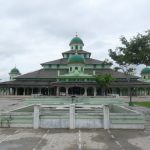
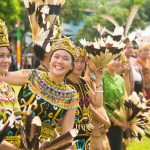
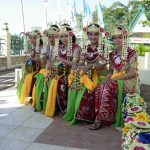

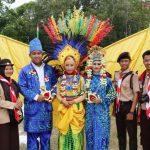
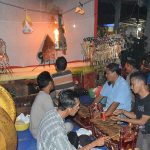

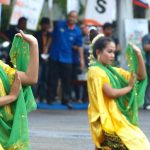
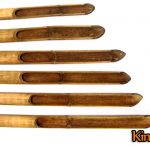
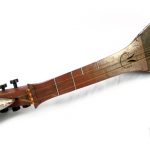
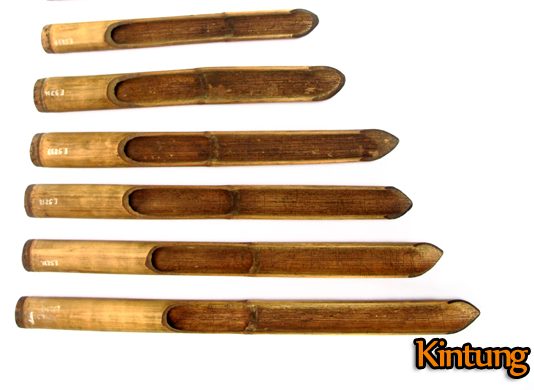
 Culture
Culture
One of the arts in the form of traditional music typical of the Banjar people is Panting. This music is called Panting because it is dominated by musical instruments called panting, a type of stringed instrument that uses strings (important) so it is called important music. Initially, the music came from the Tapin area, South Kalimantan. Panting is a musical instrument that is picked which is shaped like an Arab cork but is smaller in size.
In the past, panting music was only played individually or solo. The name of the important music comes from the name of the musical instrument itself, because in important music that is famous for its musical instruments and which plays a very important role. Until now, panting is still famous as traditional music originating from South Kalimantan.
 Besides that, there is a traditional Banjar music art, namely Kentung. This music comes from the Banjar Regency area, namely in the village of Sungai Alat, Astambul and the village of Bincau, Martapura. At present, this kentung music has begun to scarce. The past of this musical instrument was contested. In this match not only the sound, but also the things that are magical, such as if in the match this instrument can be broken or cannot be heard from the opponent’s competition.
Besides that, there is a traditional Banjar music art, namely Kentung. This music comes from the Banjar Regency area, namely in the village of Sungai Alat, Astambul and the village of Bincau, Martapura. At present, this kentung music has begun to scarce. The past of this musical instrument was contested. In this match not only the sound, but also the things that are magical, such as if in the match this instrument can be broken or cannot be heard from the opponent’s competition.
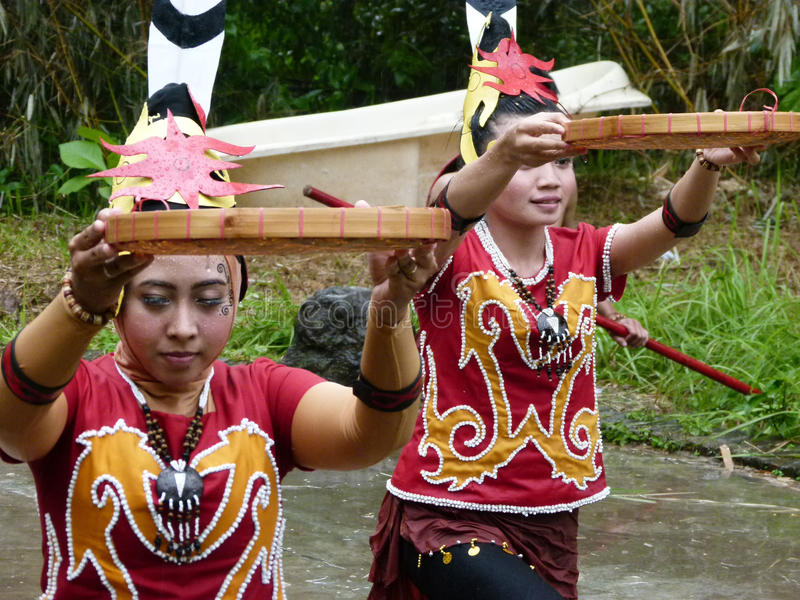 Dance from South Kalimantan is from the indigenous ethnic culture of Banjar and ethnic Dayaks. Banjar dance evolved from the time of the Banjar Sultanate and was influenced by Javanese and Malay culture, such as Japin Dance and Baksa kembang Dance.
Dance from South Kalimantan is from the indigenous ethnic culture of Banjar and ethnic Dayaks. Banjar dance evolved from the time of the Banjar Sultanate and was influenced by Javanese and Malay culture, such as Japin Dance and Baksa kembang Dance.
Banjar dance art is divided into two, namely dance developed in the palace (palace), and dance art developed by the people. Kraton dance is marked by the name “Baksa” which comes from the Javanese language (beksan) which signifies the smoothness of motion in the dance. These dances have been around for hundreds of years, since the Hindu era, but the movements and clothing have been adapted to the current situation and conditions.
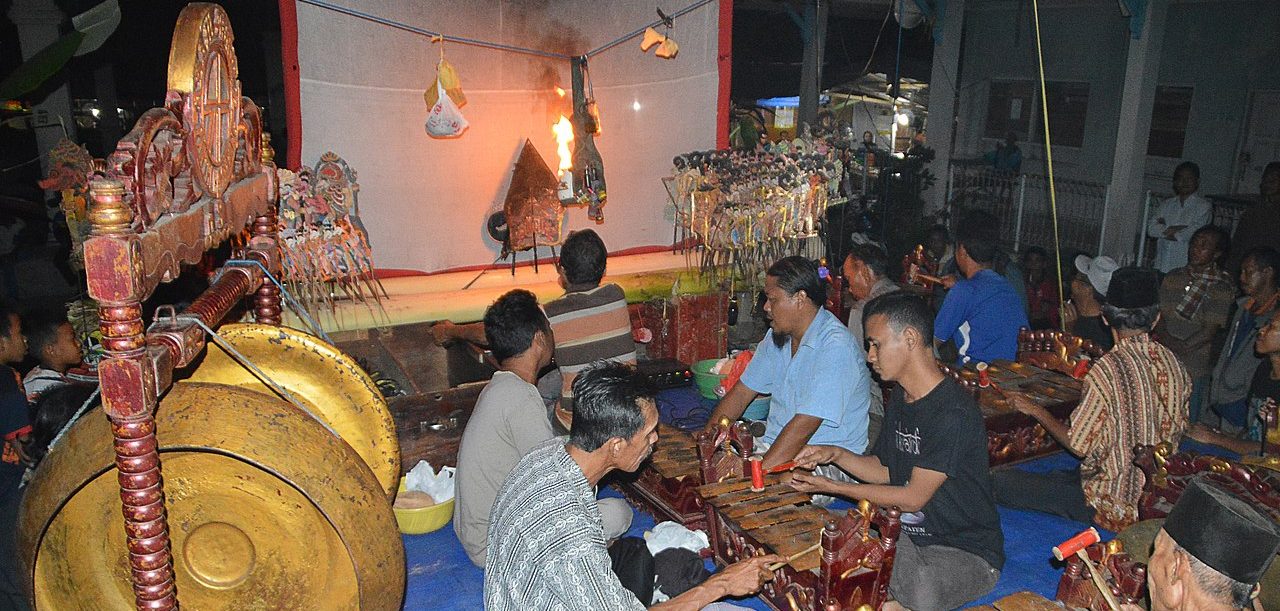 The only traditional theater art that developed on the island of Borneo was Mamanda. Mamanda is theater art or traditional performances originating from South Kalimantan. Compared to other performing arts, Mamanda is more similar to Lenong in terms of the relationship between players and spectators. This interaction made the audience become active in conveying funny comments which allegedly could make the atmosphere more lively.
The only traditional theater art that developed on the island of Borneo was Mamanda. Mamanda is theater art or traditional performances originating from South Kalimantan. Compared to other performing arts, Mamanda is more similar to Lenong in terms of the relationship between players and spectators. This interaction made the audience become active in conveying funny comments which allegedly could make the atmosphere more lively.
The difference is Lenong art is now more in line with the times than the monotonous Mamanda in the royal storyline, since in Mamanda art the characters played are standard figures such as Raja, Prime Minister, Mangkubumi, Wazir, Commander-in-Chief, First Hope, Second Hope, Khadam (Clown/aide), Empress and Sandut (Putri).
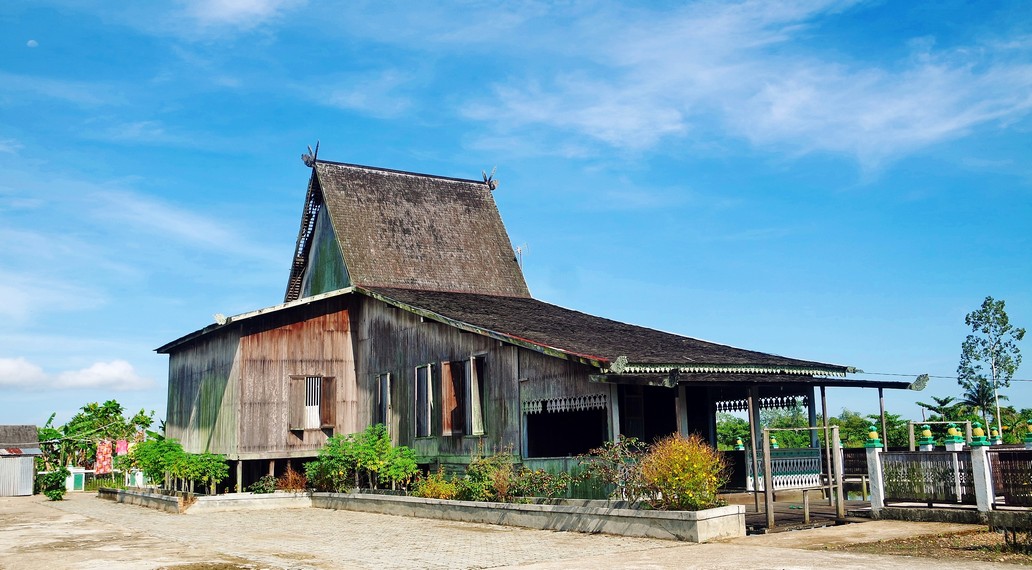 Rumah Bubungan Tinggi or Rumah Banjar or Rumah Ba-anjung is the most iconic type of house in South Kalimantan. In the old kingdom time, this house is the core building in a complex of a palace.
Rumah Bubungan Tinggi or Rumah Banjar or Rumah Ba-anjung is the most iconic type of house in South Kalimantan. In the old kingdom time, this house is the core building in a complex of a palace.
This particular house is where the King and his family would reside. Since 1850, there are various building around it with their own respective functions. The name “Bubungan Tinggi” refers to its sharp roof (45 degrees steep). This type of house became so popular, that people out of the royalty also took interest in building it.
Hence, there are houses with this type of architecture all over South Kalimantan, and even crossing the borders of Central Kalimantan and East Kalimantan. This type of house, of course, took more money than the usual house, so it was naturally the house of the rich.
 Tourism
Tourism
In South Kalimantan there are some natural attractions that consist of natural forests, long rivers swerving, lakes and highlands or mountains. In addition to natural tourism, there are several cultural and historical tours in South Kalimantan that come from the heritage of the arts and culture of the region.
The city of Banjarmasin is known for its floating market (Indonesian and Banjarese: pasar apung). The floating market is a traditional market that is located on the Barito River and is open between 6:30 a.m. to 8:00 pm. Traders and buyers here all use means of transportation (a type of boat) to peddle and search for their merchandise.
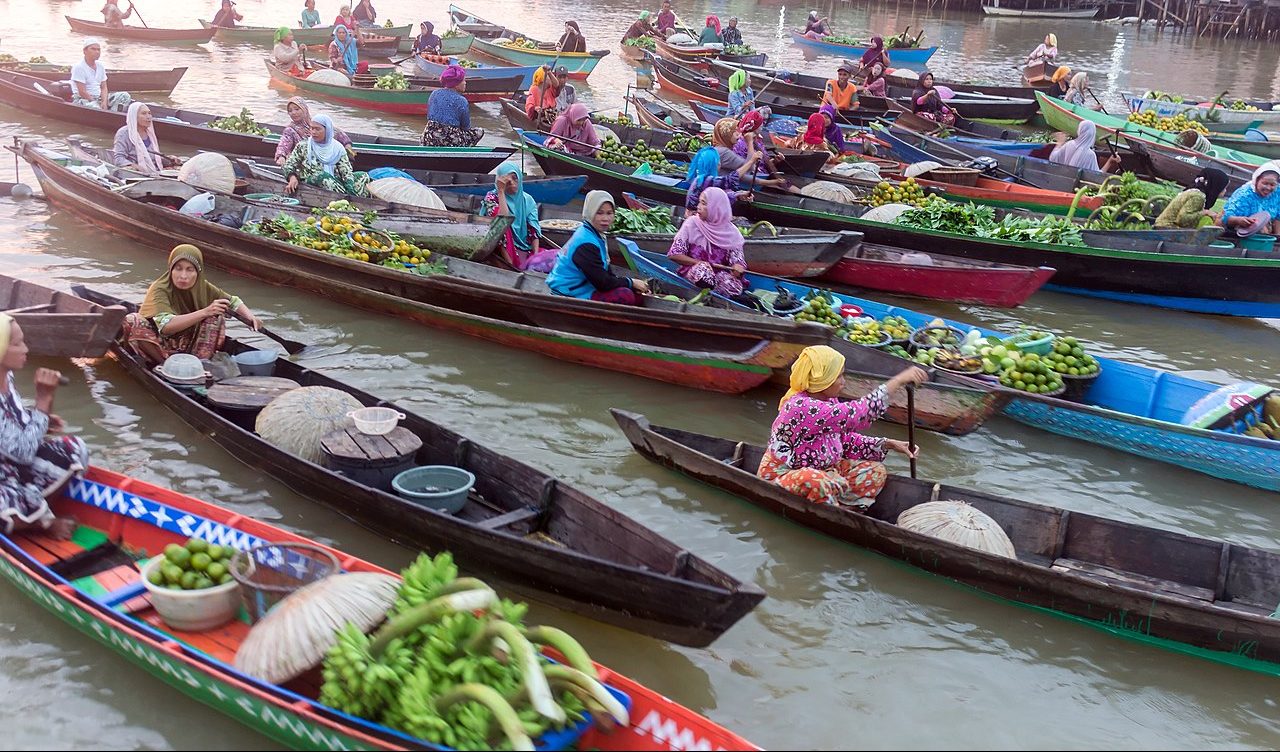 There are several floating markets in Banjarmasin. One of the legendary and popular is the Lok Baintan floating market on the Martapura River.
There are several floating markets in Banjarmasin. One of the legendary and popular is the Lok Baintan floating market on the Martapura River.
In this Floating Market, traders sell their wares using wooden boats known as jukung, here people can buy various kinds of plantation and agricultural products as well as other merchandise such as clothes, cakes and fish.
There also some Banjar specialties namely soto banjar and nasi sop banjar. Historically, like the typical market features of the past, this market was originally a place for exchanging goods between people from garden produce and agriculture, and now it uses money exchange tools.
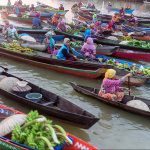
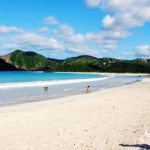

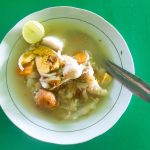
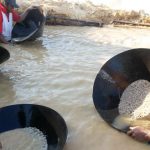
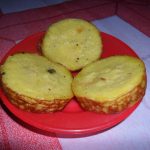
 Loksado has become a favorite for tourists not only locally but also overseas. This sub-district, located in South Hulu Sungai Regency, is home to the Meratus Mountains and a diversity of local cultures, including the Meratus Dayak people culture.
Loksado has become a favorite for tourists not only locally but also overseas. This sub-district, located in South Hulu Sungai Regency, is home to the Meratus Mountains and a diversity of local cultures, including the Meratus Dayak people culture.
The city of Martapura, South Kalimantan is the focal point of a diamond industry.
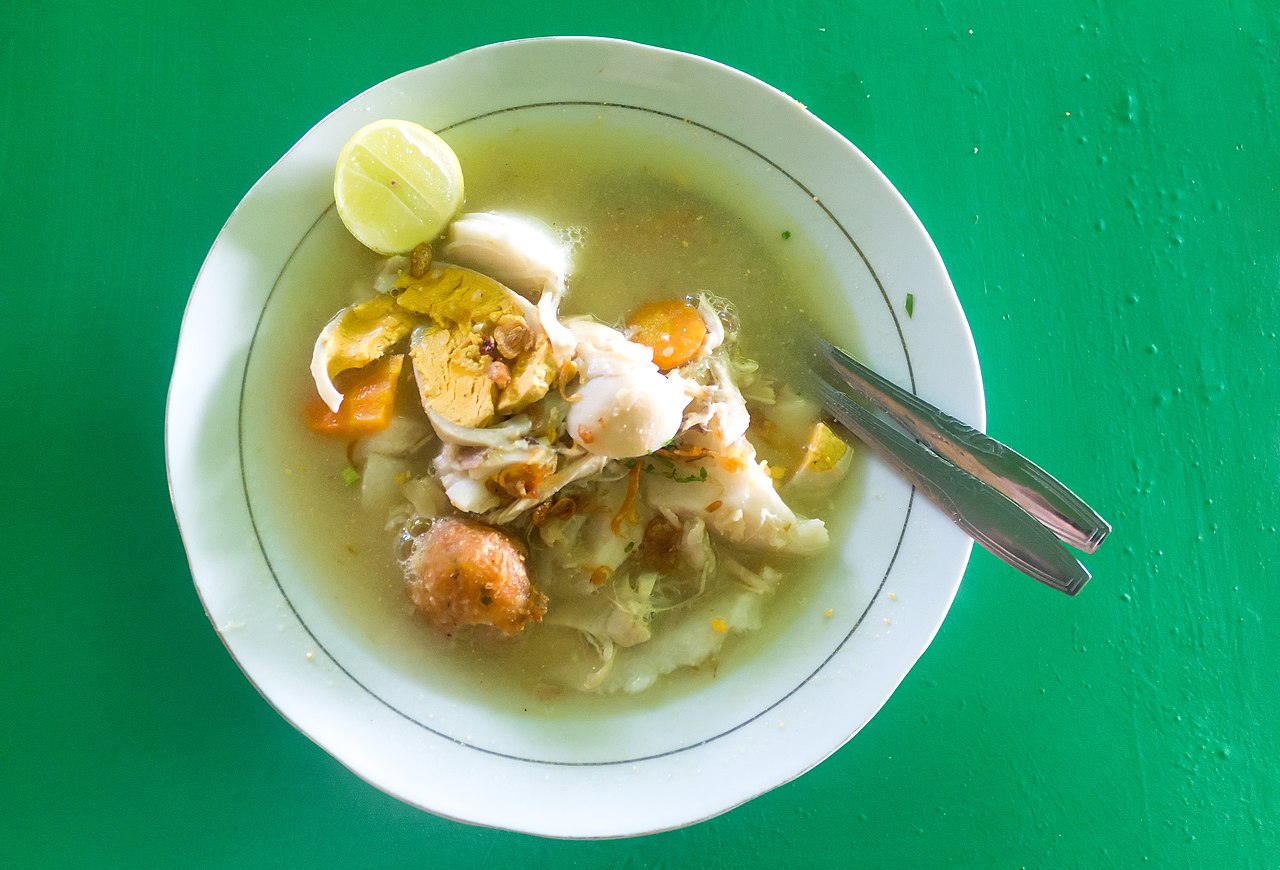 Cuisine
Cuisine
Banjarese cuisine has been influenced by many cultures, such as Malay, Javanese, Chinese and Indian. One of the famous culinary of this province is Soto Banjar. Soto banjar is served in many restaurants throughout the province.
Soto banjar is a soto made from chicken meat as its main ingredient, then added with various spices such as onion, white onion, cumin, fennel, and cinnamon to make the soto more savoury.
Additional juice from lime makes this dish eve more. fresh. This dish is usually served during lunchtime. The stalls selling Soto Banjar are not only in South Kalimantan. Outside of South Kalimantan there are also many stalls that sell Soto Banjar. Soto Banjar also has been adopted as one variant of Indomie instant noodle, representing Kalimantan cuisine.
Kabupaten & Kota

Banjarmasin
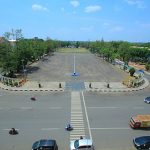
Banjarbaru
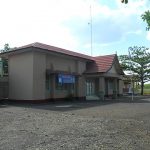
Tapin
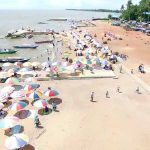
Tanah Laut

Tanah Bumbu
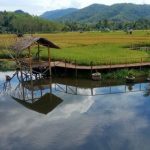
Tabalong

Kotabaru
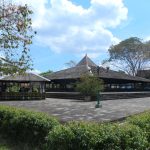
Hulu Sungai Utara
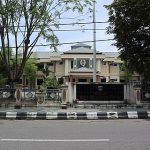
Hulu Sungai Tengah
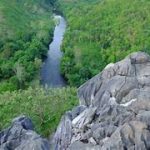
Hulu Sungai Selatan

Barito Kuala
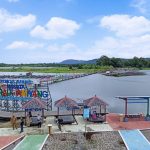
Banjar
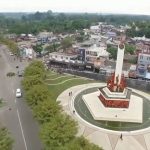
Balangan
